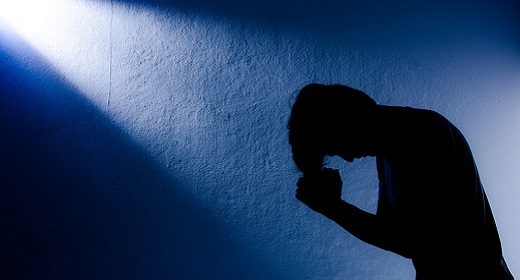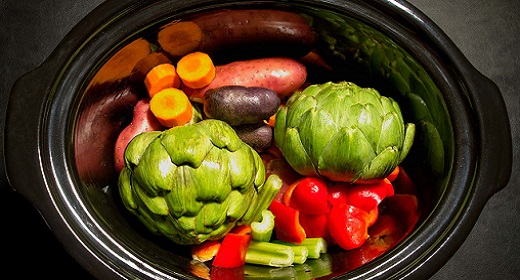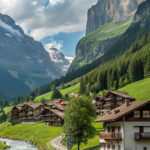by Matt Hickman: Los Angeles is a strange place. For most first-time visitors, particularly those fleeing parts of the country where the winters are frigid and unforgiving, one of the most remarkable things about L.A. is how green it is…
A bonanza of exotic and beautiful flora, the city seems to exist in a largely season-less void as a verdant — and problematically water-dependent — paradise where you can find lushness in even the smallest urban corners.
But as green as L.A. is, it’s also oppressively gray. A sprawling, freeway-laced metropolis where car culture still reigns supreme, the city’s most distinctive feature, for better but mostly worse, remains its roads. Although many Los Angelenos are choosing to buck tradition and eschew cars, one old axiom remains mostly true: Nobody walks in L.A.
The Urban Heat Island Effect
And while there are numerous qualms to be had with the thousands upon thousands of miles of blacktop that bind Los Angeles together, there’s one asphalt-exacerbated issue that the city is now tackling head on: the urban heat island effect.
As CBS Los Angeles explains, dark-colored asphalt positively bakes when temperatures rise, absorbing 80% to 95% of the sun’s rays. On a sweltering summer day when the mercury reaches 100 degrees, the surface temperature of L.A.’s roads can climb to as much as 50 degrees higher. And when these roads reach sizzling hot status, ambient heat radiates into surrounding neighborhoods. This results in stifling and unhealthy conditions for residents. It also causes energy usage to spike — as all those fans and air conditioners are switched to maximum cool.
Although heat-absorbing asphalt isn’t the only culprit behind the urban heat island effect, a phenomenon that can raise the average air temperature 22 degrees Fahrenheit in cities compared to outlying areas, it’s relatively easy to counter.
Painting Blacktop White Reduces Surface Temperature
:max_bytes(150000):strip_icc():format(webp)/__opt__aboutcom__coeus__resources__content_migration__mnn__images__2018__04__WhitePaintedStreet_LosAngeles_UrbanHeatIsland-381b576584c8477ba6d488ccef8cb21f.jpg)
The new, no-brainer solution embraced by city officials? Painting blacktop white.
Headed by the City of Los Angeles Bureau of Street Services, the city’s street painting crusade began in earnest last year in designated pilot neighborhoods. And according to preliminary testing, it’s been a success. Per the bureau, roads that have been treated with off white-ish CoolSeal, a water-based asphalt emulsion that reflects the sun’s rays instead of absorbing them, have shown to be an average of 10 to 15 degrees cooler than roads with traditional, untreated blacktop. CoolSeal, which is typically applied in two coats, has also passed crucial durability and wet skid testing.
In the notably toasty San Fernando Valley neighborhood of Canoga Park, where the pilot program kicked off, the surface temperature of one major street treated with CoolSeal was found to be a whopping 23 degrees cooler — 70 degrees versus 93 degrees — when compared to a nearby intersection not painted white.
“The city’s going to get hotter because of climate change, particularly this neighborhood of the west San Fernando Valley,” said Greg Spotts, assistant director of the Bureau of Street Services, told the Los Angeles Daily News last spring. “The phenomenon called the heat island effect means the city is hotter than the surrounding countryside.”
“We’re exploring ways to reduce the heat island effect by reducing the absorption of heat in the built environment,” he adds.
City lawmakers like Councilman Bob Blumenfield, whose district includes Canoga Park, are all in. He calls the scheme “very cool — both literally and figuratively.” However, he notes one downside: “We won’t be able to fry eggs in the street.”
“We’re going to try to make Los Angeles as cool as possible,” Jeff Luzar, national sales director for GuardTop, the Orange County-based asphalt coating manufacturer that produces CoolSeal, tells the Daily News. “We’re going to be the coolest island in Southern California.”
While GuardTop has applied CoolSeal to parking lots and playgrounds in the past, this is the first time that public streets in Los Angeles — or anywhere in California, for that matter — have received the same, temperature-lowering treatment.
It’s Expensive But Worth It
Per the Daily News, average temperatures in Los Angeles have increased 5 degrees in the past 100 years due in part to the urban heat island effect. During the summer months, average temperatures are even higher. The constantly expanding built environment — roads and freeways, rooftops, buildings, parking lots and the like — continues to drive that number upwards. This makes the need for city-cooling tactics like white roads, cool roofs and a multitude of shade-providing trees even more urgent.
But as CBS Los Angeles relays, the cost of turning blacktop white doesn’t come cheap: for every single mile of newly cooled asphalt, roughly $40,000 comes out of city coffers. What’s more, the coating only lasts seven years.
Still, advocates are confident that advances in asphalt technology will drive down the cost. There’s also the related economic benefits to consider: in once-sweltering neighborhoods where streets are now painted white, residents will be less likely to crank the air conditioning on full blast, leading to significant savings on energy bills and decreased emissions. What’s more, the highly reflective nature of white-coated asphalt means that street lighting doesn’t have to kick in quite as early in the evening, saving additional energy. Public health will also get a boost, particularly during potentially dangerous heat waves made worse by heat-radiating asphalt.
Other Warm Weather Cities Are Considering It
:max_bytes(150000):strip_icc():format(webp)/__opt__aboutcom__coeus__resources__content_migration__mnn__images__2018__04__DowntownPhoenix_Skyline-70290edd74a14d8ea398de8e808b9be0.jpg)
Outside of Los Angeles, leaders of other warm weather cities made uncomfortably warmer by the urban heat island effect such as Phoenix are paying attention to see how these test areas fare — 15 in total, each a block-long and located in mostly low-traffic residential areas around Los Angeles.
While Phoenix has no immediate or specific plans to render its blacktop white, the city’s Street Transportation Department is looking into methods of lowering temps made higher by the built environment. To that end, AZCentral reports that Phoenix plans to release an urban heat island master plan later this year. Much of this plan will revolve around maintaining, protecting and expanding Phoenix’s urban canopy. Currently, the city’s canopy is between 9% and 12%. The goal is to reach 25% tree coverage.
“I’ve come back to the same question multiple times as have many others, which is how much can you cool a city through these different strategies?” David Sailor, director of the Urban Climate Research Center at Arizona State University, explains to AZCentral. “There’s more than one way to cool the environment.”










































